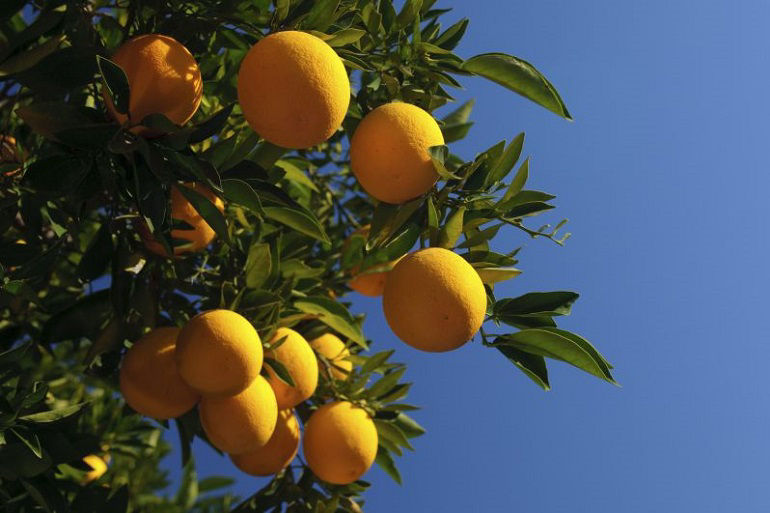Knowing the Signs of HLB in Citrus
July 28, 2022

HLB symptoms can appear any time, but they’re most readily observed between September and March, says Joel Nelsen, president of the Exeter-based California Citrus Mutual. He notes the bacteria can invade leaves, twigs and fruit and, indeed, all parts of a tree’s canopy. The most telltale symptom is blotchy mottle, which is a random pattern of yellowing that is asymmetrical on the right and left sides of the leaf.
Scientists note blotchy mottle is the best diagnostic leaf symptom of HLB. According to Nelsen, there is no best way to scout for HLB. There are two approaches for early detection of HLB:
- Select leaves at the bottom of all four quadrants and submit them to a local lab for a polymerase chain reaction (PCR) test to detect the presence of the bacterium.
- Look for symptomatic leaves in the upper portion of the tree. By the time the bacterium reaches the upper portion, there will usually be sufficient levels for detection.
The bacterium is transmitted in one of two ways: A diseased graft is attached to the tree, or one or more psyllids lands on a tree and transmits the bacterium while feeding.
HLB may need three to five years to infect an entire tree, rendering the disease difficult to catch early. A robust scouting program is a must to spot populations of citrus psyllids and watch for early signs of HLB. Controlling psyllid populations and removal of infected trees are critical steps for preventing the spread of the disease, Nelsen says.
The disease generally travels to a particular quadrant of the tree, although there’s no telling which quadrant it will choose. “You can sample one portion and it will be clean, but another part of the tree will be infected,” Nelsen says. That localization means that all parts of a tree must be monitored for signs of disease.
Encroaching Threat
The difficulty in detecting HLB has led to its spread throughout other parts of the country and the world. California growers should take note of these trends, Nelsen says:
- Florida citrus production declined 61% between 2003-04 and 2014-15, in part due to HLB, according to U.S. Department of Agriculture data.
- In Texas, HLB has been detected and is spreading.
- Agriculture data and technology firm Gro-Intelligence reported in February 2017 that HLB had spread to 23 of Mexico’s 31 states since 2009.
- China has lost 10% of its citrus tree volume.
Nelsen worries that California could be the only remaining citrus-producing state in the next three to five years because of the damage HLB is causing in Florida and Texas.
“California could be next,” Nelsen says. “You have HLB in Mexico moving closer to the California border. It’s an extremely serious and sensitive situation for our industry.”
Nelsen worries that California could be the only remaining citrus-producing state in the next three to five years because of the damage HLB is causing in Florida and Texas. “We’re real keen on doing what we can do to make sure history doesn’t repeat itself in California,” he says.
Preventive Measures
Now that HLB has been detected in residential areas of California, experts say there likely is only a narrow window of time to find a cure before HLB finds its way into commercial groves in California.
“We have probably two years before we see it in commercial citrus orchards in California,” notes Elizabeth Grafton-Cardwell, an Extension specialist with the University of California-Riverside. “In the meantime, we should be controlling psyllids because the psyllids are moving the disease. If the psyllid populations are kept very low, we’re reducing the risk of spreading the disease.”
The seriousness of the threat outweighs all other pest concerns, researchers say. But while research is the key to prevention of HLB, the effort requires an investment of resources. California growers and the government are stepping up to the plate in the following ways:
- California Citrus Mutual has raised $8 million from industry members to fund a new biosecurity lab that will focus on finding a cure for HLB.
- California is part of the USDA’s Citrus Health Response Program, which includes $25 million per year spent on analyzing ACP and citrus leaves to determine whether HLB is present.
Finding a Solution
Bayer offers a portfolio of insecticides that control current pests in California including Movento® and Sivanto™, as well as Admire® Pro and Baythroid® XL. This proven portfolio provides the foundation of season-long ACP control with multiple modes of action, application timings and methods to ensure crop quality and help California citrus growers stay ahead of HLB.